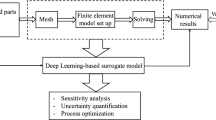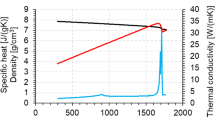Abstract
Understanding the thermal behavior of additive manufacturing (AM) processes is crucial for enhancing the quality control and enabling customized process design. Most purely physics-based computational models suffer from intensive computational costs and the need of calibrating unknown parameters, thus not suitable for online control and iterative design application. Data-driven models taking advantage of the latest developed computational tools can serve as a more efficient surrogate, but they are usually trained over a large amount of simulation data and often fail to effectively use small but high-quality experimental data. In this work, we developed a hybrid physics-based data-driven thermal modeling approach of AM processes using physics-informed neural networks. Specifically, partially observed temperature data measured from an infrared camera is combined with the physics laws to predict full-field temperature history and to discover unknown material and process parameters. In the numerical and experimental examples, the effectiveness of adding auxiliary training data and using the pretrained model on training efficiency and prediction accuracy, as well as the ability to identify unknown parameters with partially observed data, are demonstrated. The results show that the hybrid thermal model can effectively identify unknown parameters and capture the full-field temperature accurately, and thus it has the potential to be used in iterative process design and real-time process control of AM.














Similar content being viewed by others
Data Availability
Our code and data can be found at https://github.com/ShuhengLiao/Physics_informed_AM.
References
Smith J, Xiong W, Yan W, Lin S, Cheng P, Kafka OL, Wagner GJ, Cao J, Liu WK (2016) Linking process, structure, property, and performance for metal-based additive manufacturing: computational approaches with experimental support. Comput Mech 57(4):583–610
Mukherjee T, Wei H, De A, DebRoy T (2018) Heat and fluid flow in additive manufacturing-part I: modeling of powder bed fusion. Comput Mater Sci 150:304–313
Mukherjee T, Wei H, De A, DebRoy T (2018) Heat and fluid flow in additive manufacturing-part II: powder bed fusion of stainless steel, and titanium, nickel and aluminum base alloys. Comput Mater Sci 150:369–380
Gan Z, Liu H, Li S, He X, Yu G (2017) Modeling of thermal behavior and mass transport in multi-layer laser additive manufacturing of Ni-based alloy on cast iron. Int J Heat Mass Transf 111:709–722
Gan Z, Lian Y, Lin SE, Jones KK, Liu WK, Wagner GJ (2019) Benchmark study of thermal behavior, surface topography, and dendritic microstructure in selective laser melting of inconel 625. Integrating Mater Manuf Innov 8(2):178–193
Heigel JC, Lane BM, Levine LE (2020) In situ measurements of melt-pool length and cooling rate during 3d builds of the metal am-bench artifacts. Integrating Mater Manuf Innov 9(1):31–53
Roberts IA, Wang C, Esterlein R, Stanford M, Mynors D (2009) A three-dimensional finite element analysis of the temperature field during laser melting of metal powders in additive layer manufacturing. Int J Mach Tools Manuf 49(12–13):916–923
Gao W, Zhao S, Wang Y, Zhang Z, Liu F, Lin X (2016) Numerical simulation of thermal field and Fe-based coating doped Ti. Int J Heat Mass Transf 92:83–90
Denlinger ER, Michaleris P (2016) Effect of stress relaxation on distortion in additive manufacturing process modeling. Addit Manuf 12:51–59
Lu X, Lin X, Chiumenti M, Cervera M, Hu Y, Ji X, Ma L, Yang H, Huang W (2019) Residual stress and distortion of rectangular and s-shaped Ti–6Al–4V parts by directed energy deposition: modelling and experimental calibration. Addit Manuf 26:166–179
Li T, Zhang L, Chen G, Pirch N, Schopphoven T, Gasser A, Poprawe R (2022) A combined heat source model for the prediction of residual stress post extreme high-speed laser material deposition. J Manuf Process 78:265–277
Liao S, Webster S, Huang D, Council R, Ehmann K, Cao J (2022) Simulation-guided variable laser power design for melt pool depth control in directed energy deposition. Addit Manuf 102912
Irwin JE, Wang Q, Michaleris PP, Nassar AR, Ren Y, Stutzman CB (2021) Iterative simulation-based techniques for control of laser powder bed fusion additive manufacturing. Addit Manuf 46:102078
Mozaffar M, Paul A, Al-Bahrani R, Wolff S, Choudhary A, Agrawal A, Ehmann K, Cao J (2018) Data-driven prediction of the high-dimensional thermal history in directed energy deposition processes via recurrent neural networks. Manuf Lett 18:35–39
Roy M, Wodo O (2020) Data-driven modeling of thermal history in additive manufacturing. Addit Manuf 32:101017
Ren K, Chew Y, Zhang Y, Fuh J, Bi G (2020) Thermal field prediction for laser scanning paths in laser aided additive manufacturing by physics-based machine learning. Comput Methods Appl Mech Eng 362:112734
Zhou Z, Shen H, Liu B, Du W, Jin J (2021) Thermal field prediction for welding paths in multi-layer gas metal arc welding-based additive manufacturing: a machine learning approach. J Manuf Process 64:960–971
Mozaffar M, Liao S, Lin H, Ehmann K, Cao J (2021) Geometry-agnostic data-driven thermal modeling of additive manufacturing processes using graph neural networks. Addit Manuf 48:102449
Stathatos E, Vosniakos G-C (2019) Real-time simulation for long paths in laser-based additive manufacturing: a machine learning approach. Int J Adv Manuf Technol 104(5):1967–1984
Ness KL, Paul A, Sun L, Zhang Z (2022) Towards a generic physics-based machine learning model for geometry invariant thermal history prediction in additive manufacturing. J Mater Process Technol 302:117472
Raissi M, Perdikaris P, Karniadakis GE (2019) Physics-informed neural networks: a deep learning framework for solving forward and inverse problems involving nonlinear partial differential equations. J Comput Phys 378:686–707
Raissi M, Yazdani A, Karniadakis GE (2020) Hidden fluid mechanics: learning velocity and pressure fields from flow visualizations. Science 367(6481):1026–1030
Mao Z, Jagtap AD, Karniadakis GE (2020) Physics-informed neural networks for high-speed flows. Comput Methods Appl Mech Eng 360:112789
Cai S, Wang Z, Wang S, Perdikaris P, Karniadakis GE (2021) Physics-informed neural networks for heat transfer problems. J Heat Transf 143(6):060801
Laubscher R (2021) Simulation of multi-species flow and heat transfer using physics-informed neural networks. Phys Fluids 33(8):087101
Haghighat E, Raissi M, Moure A, Gomez H, Juanes R (2021) A physics-informed deep learning framework for inversion and surrogate modeling in solid mechanics. Comput Methods Appl Mech Eng 379:113741
Zhang E, Yin M, Karniadakis GE. Physics-informed neural networks for nonhomogeneous material identification in elasticity imaging. arXiv preprint arXiv:2009.04525
Zhu Q, Liu Z, Yan J (2021) Machine learning for metal additive manufacturing: predicting temperature and melt pool fluid dynamics using physics-informed neural networks. Comput Mech 67(2):619–635
Baydin AG, Pearlmutter BA, Radul AA, Siskind JM (2018) Automatic differentiation in machine learning: a survey. J Mach Learn Res 18:1–43
Abadi M, Agarwal A, Barham P, Brevdo E, Chen Z, Citro, C, Corrado GS, Davis A, Dean J, Devin M et al. Tensorflow: large-scale machine learning on heterogeneous distributed systems. arXiv preprint arXiv:1603.04467
Paszke A, Gross S, Chintala S, Chanan G, Yang E, DeVito Z, Lin Z, Desmaison A, Antiga L, Lerer A. Automatic differentiation in pytorch
Alnæs M, Blechta J, Hake J, Johansson A, Kehlet B, Logg A, Richardson C, Ring J, Rognes ME, Wells GN. The FEniCS project version 1.5. Arch Numer Softw 3(100):9–23
Crank J, Nicolson P (1996) A practical method for numerical evaluation of solutions of partial differential equations of the heat-conduction type. Adv Comput Math 6(1):207–226
Lu L, Meng X, Mao Z, Karniadakis GE (2021) Deepxde: a deep learning library for solving differential equations. SIAM Rev 63(1):208–228
Kingma DP, Ba J (2014) Adam: a method for stochastic optimization. arXiv preprint arXiv:1412.6980
Bahmani B, Sun W (2021) Training multi-objective/multi-task collocation physics-informed neural network with student/teachers transfer learnings. arXiv preprint arXiv:2107.11496
Hu D, Kovacevic R (2003) Sensing, modeling and control for laser-based additive manufacturing. Int J Mach Tools Manuf 43(1):51–60
Liu S, Farahmand P, Kovacevic R (2014) Optical monitoring of high power direct diode laser cladding. Optics Laser Technol 64:363–376
Gibson BT, Bandari YK, Richardson BS, Henry WC, Vetland EJ, Sundermann TW, Love LJ (2020) Melt pool size control through multiple closed-loop modalities in laser-wire directed energy deposition of Ti–6Al–4V. Addit Manuf 32:100993
A International, AIR Publications, AS for Metals (1989) Reference Publications. ASM Engineered Materials Reference Book, ASM International (OH)
Mills KC (2002) Recommended values of thermophysical properties for selected commercial alloys. Woodhead Publishing
Kozjek D, Carter FM III, Porter C, Mogonye J-E, Ehmann K, Cao J (2022) Data-driven prediction of next-layer melt pool temperatures in laser powder bed fusion based on co-axial high-resolution planck thermometry measurements. J Manuf Process 79:81–90
Yang M, Wang L, Yan W (2021) Phase-field modeling of grain evolutions in additive manufacturing from nucleation, growth, to coarsening. NPJ Comput Mater 7(1):1–12
Lu L, Pestourie R, Yao W, Wang Z, Verdugo F, Johnson SG (2021) Physics-informed neural networks with hard constraints for inverse design. SIAM J Sci Comput 43(6):B1105–B1132
Acknowledgements
This work was supported by National Institute of Standards and Technology (NIST)-Center for Hierarchical Material Design (CHiMaD) under grant No. 70 NANB19H005, and the Department of Defense Vannevar Bush Faculty Fellowship, USA N00014-19-1-2642.
Author information
Authors and Affiliations
Corresponding author
Additional information
Publisher's Note
Springer Nature remains neutral with regard to jurisdictional claims in published maps and institutional affiliations.
Rights and permissions
Springer Nature or its licensor (e.g. a society or other partner) holds exclusive rights to this article under a publishing agreement with the author(s) or other rightsholder(s); author self-archiving of the accepted manuscript version of this article is solely governed by the terms of such publishing agreement and applicable law.
About this article
Cite this article
Liao, S., Xue, T., Jeong, J. et al. Hybrid thermal modeling of additive manufacturing processes using physics-informed neural networks for temperature prediction and parameter identification. Comput Mech 72, 499–512 (2023). https://doi.org/10.1007/s00466-022-02257-9
Received:
Accepted:
Published:
Issue Date:
DOI: https://doi.org/10.1007/s00466-022-02257-9




